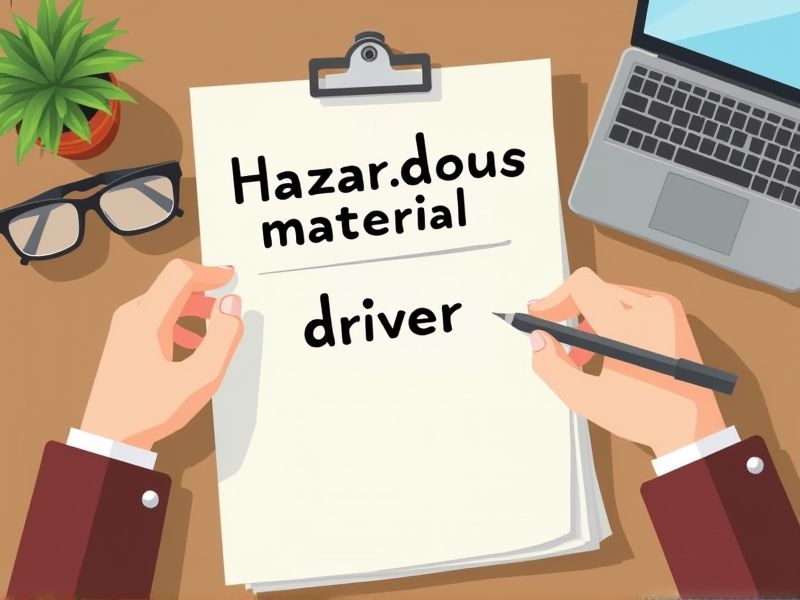
Driving hazardous materials requires a specialized skill set due to the inherent risks involved in transporting potentially dangerous substances. Certifications ensure drivers are knowledgeable in handling, storing, and transporting these materials safely, minimizing the risk of accidents and environmental damage. Regulatory bodies mandate these certifications to maintain public and environmental safety standards. Key certifications are essential for anyone aspiring to become a hazardous material driver.
Commercial Driver's License (CDL) with Hazardous Materials Endorsement
To ensure public safety, the federal government mandates a Commercial Driver's License (CDL) with a Hazardous Materials Endorsement for those transporting sensitive cargo. Proper training for a CDL with this endorsement equips drivers with knowledge about material handling, emergency response, and regulatory compliance. Accidents decreased due to the specialized training and awareness gained through obtaining the endorsement. Regulatory bodies can effectively monitor and control the movement of dangerous goods, reducing environmental and public health risks.
Hazardous Materials (HazMat) Certification
Hazardous Materials (HazMat) Certification ensures drivers understand the risks associated with transporting dangerous goods, reducing the likelihood of accidents. Regulatory compliance mandates certification as a requirement to uphold safety standards and avoid legal repercussions. Training equips drivers with the necessary skills to handle emergency situations effectively, minimizing potential harm. Insurance companies often require certification to assess risk accurately and adjust policy terms accordingly.
Transportation of Dangerous Goods (TDG) Certification
Transportation of Dangerous Goods (TDG) Certification is necessary for hazardous material drivers because it ensures they have adequate knowledge of legal and safety requirements, reducing the risk of accidents during transit. With this certification, drivers are trained to handle emergency situations effectively, minimizing potential harm to themselves and the public. TDG Certification allows enforcement of standardized practices, promoting consistent compliance with regulations across different regions. Proper certification instills public confidence in the safe transportation of hazardous materials, thereby supporting a trustworthy and functional supply chain.
Emergency Response Training for Hazardous Materials
Emergency response training for hazardous materials is crucial for drivers because it equips them with the ability to manage potential spills or leaks, minimizing environmental and health risks. This training ensures drivers know how to protect themselves and the public in case of an accident involving dangerous substances. Regulatory bodies often mandate such training to comply with safety standards and legal requirements. Having trained drivers can reduce financial liabilities associated with hazardous material incidents.
OSHA HAZWOPER Certification
Hazardous material drivers encounter high-risk substances during transportation, necessitating a comprehensive understanding of safety procedures for their protection, achievable through OSHA HAZWOPER Certification. This certification ensures drivers are equipped to handle emergencies, such as chemical spills, reducing potential harm to themselves and the environment. HAZWOPER training provides critical skills in hazard recognition, which is essential for ensuring compliance with regulatory standards while transporting dangerous goods. Without proper certification, drivers may lack the necessary preparedness for managing hazardous exposure, culminating in increased risks of accidents and legal repercussions.
Defensive Driving Course Certification
A Defensive Driving Course Certification improves a hazardous material driver's ability to anticipate and respond to potential road hazards, reducing the likelihood of accidents. Given the dangerous nature of transporting hazardous materials, this certification equips drivers with techniques to mitigate risks associated with their cargo. Regulatory bodies often mandate the certification to ensure a uniform standard of safety across the industry. Historical data shows that trained drivers have a lower rate of incidents, emphasizing the certification's role in public and environmental safety.
First Aid and CPR Certification
Hazardous material drivers often face environments where accidental exposure or spills can lead to medical emergencies; possessing First Aid and CPR certification equips them to respond effectively. Knowing how to quickly administer aid in such situations helps in stabilizing affected individuals until professional medical assistance arrives, potentially saving lives. Companies prioritize drivers with these certifications to enhance safety protocols and comply with health and safety regulations. Comprehensive training in First Aid and CPR also fosters a culture of safety awareness and preparedness among hazardous material drivers.
DOT Compliance and Safety Certification
The Department of Transportation (DOT) Compliance and Safety Certification is essential for hazardous material drivers because it ensures they are trained to handle dangerous substances safely, reducing the risk of spills and accidents. Regulatory compliance mitigates legal liabilities for transportation companies, safeguarding them against potential fines and litigation. Proper certification assures communities that drivers are qualified, maintaining public trust in the safety of transportation infrastructure. A standardized certification framework establishes consistency in safety practices across the industry, promoting an efficient and secure transport environment.
Load Securement and Cargo Safety Certification
Drivers transporting hazardous materials need Load Securement and Cargo Safety Certification because improper securement can lead to spills or leaks, causing environmental damage and health risks. The certification ensures drivers understand regulatory compliance, reducing the chance of legal penalties for unsafe transportation. Proper training minimizes the risk of accidents on the road, which can result in costly liability claims and disruptions. Knowledge in safe handling and securement techniques promotes public safety and maintains industry standards.
Risk Management and Incident Reporting Certification
Risk Management and Incident Reporting Certification is crucial for hazardous material drivers because it reduces the likelihood of accidents and spills. Proper training ensures that drivers understand how to handle unexpected events, minimizing environmental and health risks. Certification also instills confidence in employers and the public, highlighting a commitment to safe and responsible transport. Regulatory compliance often mandates such certifications, protecting companies from legal repercussions and financial penalties.
Summary
By obtaining certifications, you enhance your qualifications and credibility as a hazardous material driver. This leads to more job opportunities with competitive salaries due to your specialized expertise. With enhanced skills and knowledge, you improve safety compliance and reduce the risk of accidents. Employers recognize your commitment to professionalism, which positively affects career advancement and job stability.
